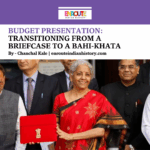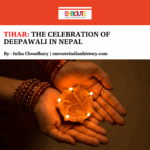Article Written By EIH Researcher And Writer
Snehal Shirpurkar
Guru Ka Langar (henceforth, Langar) is the Sikh practice of eating and preparing a communal meal. It operates through a community kitchen attached to a gurdwara: “the door to the Guru”, the site of worship and congregation for Sikh communities across the world. Three among the most important democratic institutions among Sikhism fostered by Guru Nanak include seva, langar and sangat. Considering this fundamental institutional status accorded to langar, it is no surprise that langar is served in huge quantities in gurdwaras across the world. In places outside the subcontinent with a large Sikh diaspora such as Toronto, Hong Kong, New York, San Francisco, New York, hold lavish langars, especially during Gurupurab. It is a fundamental institution that, as Nikki Singh (2011) writes, “asserts the social equality and familyhood of humanity” (p.87). Everyone, regardless of caste, faith or race is welcome to consume and help prepare the meal. Singh further comments on the constituents of the langar meal: lentils, vegetables, and wheat flatbread (phulka, roti or chappati), adding that French fries and other local treats are being incorporated for delights of the younger members of the faith. This suggests room for certain flexibilities in the institution. During special events, it is also not spatially restricted to the Gurdwara, spreading out into roads and highways- stopping pedestrians, buses, cars, rickshaws, offering respite to tiring travellers. The Persian origins of the word itself which refer to a Sufi almshouse and spiritual anchor hint at the roles it might have, and continues to play in the practice of the Sikh faith today.
This essay explores this popular practice of langar: its place in Sikh history, what it can tell us about Sikh communities, and the interactions between Sikh communities and the rest of the world that are mediated by the act of langar.
Situating Langar in Sikh History
Sikhism, after its inception in 1469 with the birth of Guru Nanak, saw the formation of the first Sikh community in Katarpur, the village founded by Nanak by the banks of the river Ravi. Following Nanak’s death, the accounts of his life written by followers proliferated, and thus formed the corpus of ‘Janamsakhi Literature’ (Janam is the Punjabi word for birth whereas sakhi means story). While not a source meant for strictly historical purposes, it divulges valuable information about the spiritual figure and the institutions they are thought to have popularized. The three aforementioned institutions evolved amidst the community in Katarpur after Nanak is initiated as the Guru hinge on the rejection of hierarchies that hitherto characterized society: those of caste, class and gender. In a social fabric so deeply enmeshed with vertical and horizontal hierarchies, “Together they [the followers] listened to and recited the sacred hymns, together they cooked and ate the langar, and together they formed a democratic congregation without priests or ordained ministers” (Singh 2011, p.11). The singular Divine conceptualized as the Ikk Onn Kar and how to feel closer to the Singular Divine, through the democratic institutions, of which langar was central, became the mainstay of the faith. It is worth mentioning here that a milieu characterized by restricted access to places of worship, deeply entrenched Brahmanical notions of purity and pollution being the norm, the idea of inter-dining among castes was a highly subversive and revolutionary act to propagate.
It is the wife of Guru Angad, regarded as the successor of Guru Nanak, Mata Khivi, who advances the practice of langar from a mere symbolic meal to a feast, and closer to the form as we know it today. Her additions of kheer, and the supervision provided by her contribute to the regularization of the practice. It is for good reason then, that Mata Khivi is referred to as “a thickly leaved tree” that provides shade for everyone because of her service and contributions to langar. With successive third, fourth and fifth Gurus, namely Guru Amar Das, Guru Ram Das and Guru Hargobind the faith expands in its followers, acquires a martial dimension, gets increasingly codified and is accompanied by an enhancement in the regularization of langar on a large scale. Guru Amar Das, curiously, insisted that all those who met him enjoyed a langar meal first: attesting to the practice’s role in forging relationships in the faith. It was under the sixth Sikh Guru, Guru Arjan Dev that langar “blossomed into its full glory.”
An interesting anecdote about langar comes from the life story of the tenth and the last Sikh Guru, Guru Gobind Singh. A queen named Mania, a child-less woman, longed for a son on witnessing the exploits of the four-year-old Guru. The Guru reciprocates by pronouncing their relationship equivalent to that of a son and a mother. They become friends, and Mania would regularly give corn to Guru Gobind Singh. Thus, corn found its way into langar. Corn continues to be served as part of langar at the Patna Sahib Gurdwara, Patna being the site where this friendship blossomed.
The rise of the Khalsa in the colonial period, the development of the Rahit-nama literature further codify langar, and scholar attests to the role of langar in historical institutional building processes in the politics of the Khalsa.
Thus, Langar has a history that dates back to the inception of the Sikh faith and finds continuity in it. It continues to be regarded as an institution crucial to the community. The next section of this essay attempts to answer these compelling questions: What has sustained Langar and what is its relation to the community- both Sikh and non-Sikh?
Langar and Community
The idea of serving and part-taking in the Langar has been considered to be meritorious for Sikh communities. In life and death, langar is a crucial ritual. The birth of a child is accompanied by a celebration through langar: a personal celebration thus transcends into the realm of community. At each death anniversary, the family serves langar to the community and in doing so, establishes a communal sense of loss and a reminder of their deceased loved one’s legacy.
The practice of langar is a ‘communion’: not just between the Divine and the eater, but also, and just as importantly, among the person eating, and among the people eating and those who prepared and served the meal; and as such, it is thought to nourish not only the body, but also the spirit. Langar engenders a feeling of family. This is because the notion of a family meal is extended and multiplied through the act of partaking in langar: from inside the home to the pangat, as rows of people sit, serve and prepare the same food.
For migrants away from home, the act of partaking in langar emerges as a crucial way to assert and articulate their common identities. In Canada for instance, Desjardins and Desjardins described langar as a bonding exercise. The limitations of authentically asserting one’s culture in a foreign land: the inability to find certain ingredients, possible initial struggles in finding a space for congregation also forces the community to collectively adapt to these- challenges also serving as potentials for forming closer bonds within the diaspora community. The practices abroad have often led to contention back home, however, as is demonstrated by the contests over the questions of adding chairs and seats to the langar. The Langar, as it forms a crucial role in creating a sense that it is transporting these migrants back home also functions as a site where memories refigure in new ways- as it sustains links with a familiar atmosphere from back home.
The philanthropic role of the act of langar, however, is perhaps its most famous dimension after their role in the COVID-19 pandemic. In the times when Delhi was reeling from heavy violence after the 2019 pogrom, gurdwaras became shelters for victims, and hospitals the site of langar. During the pandemic, the fact that there arose an “Oxygen Langar ” only attests to the prominent place accorded to langar. Abroad, amidst protests during the Black Lives Matter Movement, there arose ad hoc langars to feed the peaceful protestors. These acts of giving to the community form a crucial tenet of Sikhism. It is important here to mention that these are guided by mutual respect and sharing among equals, and not a paternalistic notion of charity.
This article attempted to trace the connections the popular practice of langar has: within and with communities, with the textual lives and spiritual past of the faith. The study of langar has broader implications for community histories, religious history, as well as food history, and even a field such as diaspora and migration studies. Now a common practice for the everyday Indian, it is important that we reckon with these broader facets of the practice.
Bibliography
Abraham, Bobins. “Providing Shelters and Organising Langar, How Sikh Community Is Helping Delhi Riot VictimsB.” IndiaTimes, March 2, 2020. https://www.indiatimes.com/news/india/providing-shelters-and-organizing-langar-this-is-how-sikh-community-is-helping-delhi-riot-victims-507371.html.
Global Sikhs: Histories, Practices and Identities. N.p.: Taylor & Francis, 2023.
Kanwarjeet Singh, Jane Southcott & Damien Lyons (2021) From our post qualitative kitchen: a Langar meal of knowledge, International Journal of Qualitative Studies in Education, DOI: 10.1080/09518398.2021.1982051
Krishna, Priya. “How to Feed Crowds in a Protest or Pandemic? The Sikhs Know.” (2020).
Navreet Kaur Rana (2022) Exploring Commensality in Sikh foodways, Sikh Formations, DOI: 10.1080/17448727.2022.2084943
Singh, Pashaura, and Louis E. Fenech, eds. The Oxford handbook of Sikh studies. Oxford University Press, 2014.
Singh, Nikky-Guninder Kaur. Sikhism. Netherlands: Facts on File, 1993.
Singh, Nikky-Guninder Kaur. Sikhism: An Introduction. United Kingdom: I.B.Tauris, 2011.
Sinha, Jignasa. “Delhi: At Gurdwara Oxygen Langar, Many Covid Patients Get a Breath of Life.” The Indian Express, May 6, 2021. https://indianexpress.com/article/cities/delhi/delhi-at-gurdwara-oxygen-langar-many-covid-patients-get-a-breath-of-life-7305005/.
Tanabe, Sean. “Let’s Meet at the Langar: How the Sikh Community has Persevered and Thrived in the US.” Global Societies Journal 2 (2014).



















